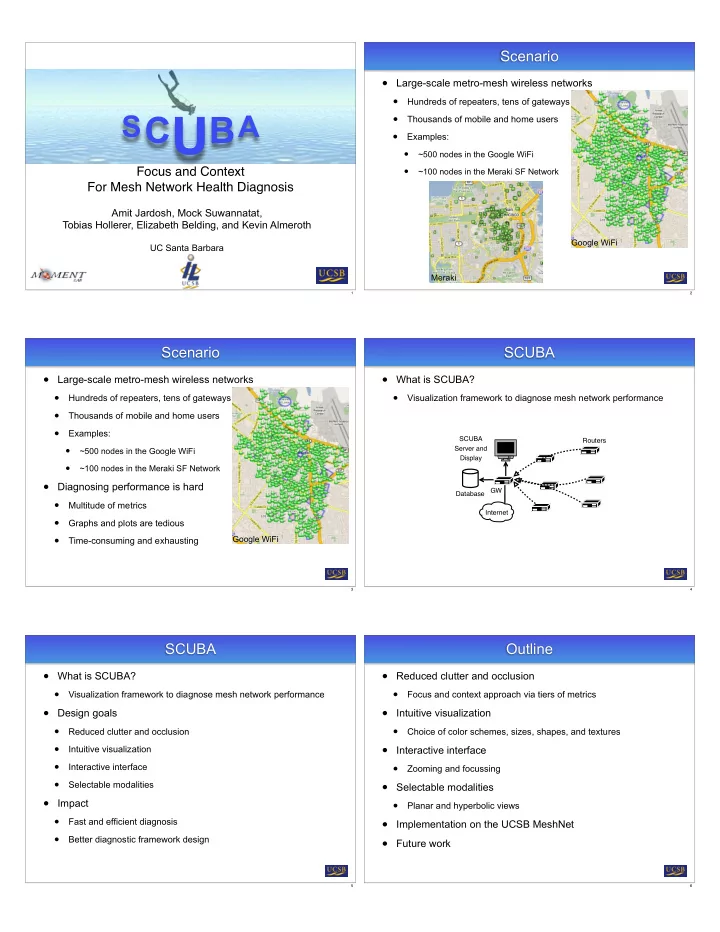

Scenario • Large-scale metro-mesh wireless networks • Hundreds of repeaters, tens of gateways S C U B A • Thousands of mobile and home users • Examples: • ~500 nodes in the Google WiFi • Focus and Context ~100 nodes in the Meraki SF Network For Mesh Network Health Diagnosis Amit Jardosh, Mock Suwannatat, Tobias Hollerer, Elizabeth Belding, and Kevin Almeroth Google WiFi UC Santa Barbara Meraki 1 2 Scenario SCUBA • • Large-scale metro-mesh wireless networks What is SCUBA? • • Hundreds of repeaters, tens of gateways Visualization framework to diagnose mesh network performance • Thousands of mobile and home users • Examples: SCUBA Routers • Server and ~500 nodes in the Google WiFi Display • ~100 nodes in the Meraki SF Network • Diagnosing performance is hard GW Database • Multitude of metrics Internet • Graphs and plots are tedious • Google WiFi Time-consuming and exhausting 3 4 SCUBA Outline • • What is SCUBA? Reduced clutter and occlusion • • Visualization framework to diagnose mesh network performance Focus and context approach via tiers of metrics • • Design goals Intuitive visualization • • Reduced clutter and occlusion Choice of color schemes, sizes, shapes, and textures • • Intuitive visualization Interactive interface • • Interactive interface Zooming and focussing • • Selectable modalities Selectable modalities • Impact • Planar and hyperbolic views • • Fast and efficient diagnosis Implementation on the UCSB MeshNet • • Better diagnostic framework design Future work 5 6
Reducing clutter and occlusion Intuitive visualizations • • Focus-and-context approach Intuition • • Organize metrics into tiers or contexts a keen or quick insight , ability to understand immediately • • Top-most context = broad overview; bottom-most = most detail SCUBA’s choice of intuition: Highlight problems • Color schemes, shapes and sizes, and textures Route Focal area Contexts Low throughput Route throughput and RTT Low RTT High RTT High throughput Low throughput and High RTT Link Route Link quality via ETX High ETT Lower ETT Link Client High Channel Utilization and Low RSSI Channel utilization, RSSI, external interference Low Channel Utilization Detail and High RSSI RSSI Client � Channel Utilization 7 8 Sample network Visualization examples • • Google WiFi Route and link contexts • • 425 routers, 66 gateways Routes are curved lines from routers to GWs • • ~2000 clients per day Links are straight lines between nodes • Metrics displayed on mouse-overs • Tailored data • ETX is proportional to distance • Routes are shortest paths to • Client context closest gateways • • Random number of clients per Circle sectors represent a client node • Client metrics displayed on mouse-overs • Route throughput and RTT is based on number of hops + some randomness 9 10 Motivation for focus-and-context Interactive interfaces 11 12
★ Selectable modalities Hyperbolic view • • Idea Provide different perspectives • • Projection of a planar view on a Colors, shapes, textures hyperbolic surface • P Spatial views P’ • Side Point of interest on focal center F • View Colors, shapes, textures • F h Other points P • Highlight problems vs. Actual performance • on the hyperbolic surface Hyperbolic Surface Low RTT High RTT Low RTT High RTT • towards the edge 2-D Plane P’ • oriented from F P • Spatial views • Number of contexts at P F • Planar and Hyperbolic • distance from F Front View • height h of the hyperbola ★ T. Munzner. Interactive Visualization of Large Graphs and Networks. PhD thesis, Stanford University, June 2000. 13 14 Views trade-off SCUBA on the UCSB MeshNet • • Planar view UCSB MeshNet • • Preserves geographic location and orientation of nodes 15 nodes (14 repeaters and 1 gateway) on three floors • • Hyperbolic view Metrics from each node stored in a SQL database • • SCUBA reads metrics from the database Preserves global view and automatically adjusts contexts • Problem diagnosis • Artificial problem client introduced Route context Link context Client context GW 15 16 Conclusions Future work • • As networks grow larger, diagnosis becomes harder Additional dimensions • • Time - to diagnose temporal problems such as flash-crowds Good visualization tools are important • 3D Scuba - to use the height as another information descriptor • Research on key metrics and visualization is necessary • SCUBA and the collection of metrics • Scuba is a diagnostic framework • Focus-and-context used to control when/which metrics are collected • Metrics organization and interaction with visuals • Qualitative study of SCUBA usability • • Eases diagnosis How useful is SCUBA in a variety of scenarios? • • Future of large-scale complex metro networks Auto-focus on problems • • Use of thresholds and temporal changes to self-identify problems Auto-diagnostic tools and protocols will become very useful • Quantitative study for speed and accuracy of diagnosis • Scuba is a means of diagnosis as well as planning 17 18
Questions? • SCUBA: Focus and Context for Mesh Health Diagnosis • Contact: amitj@cs.ucsb.edu or mock@cs.ucsb.edu • Video demo of SCUBA on • http://moment.cs.ucsb.edu/conan/scuba • 3D version of SCUBA and code • http://cs.ucsb.edu/~mock/netvisual/for290i/ 19
Recommend
More recommend